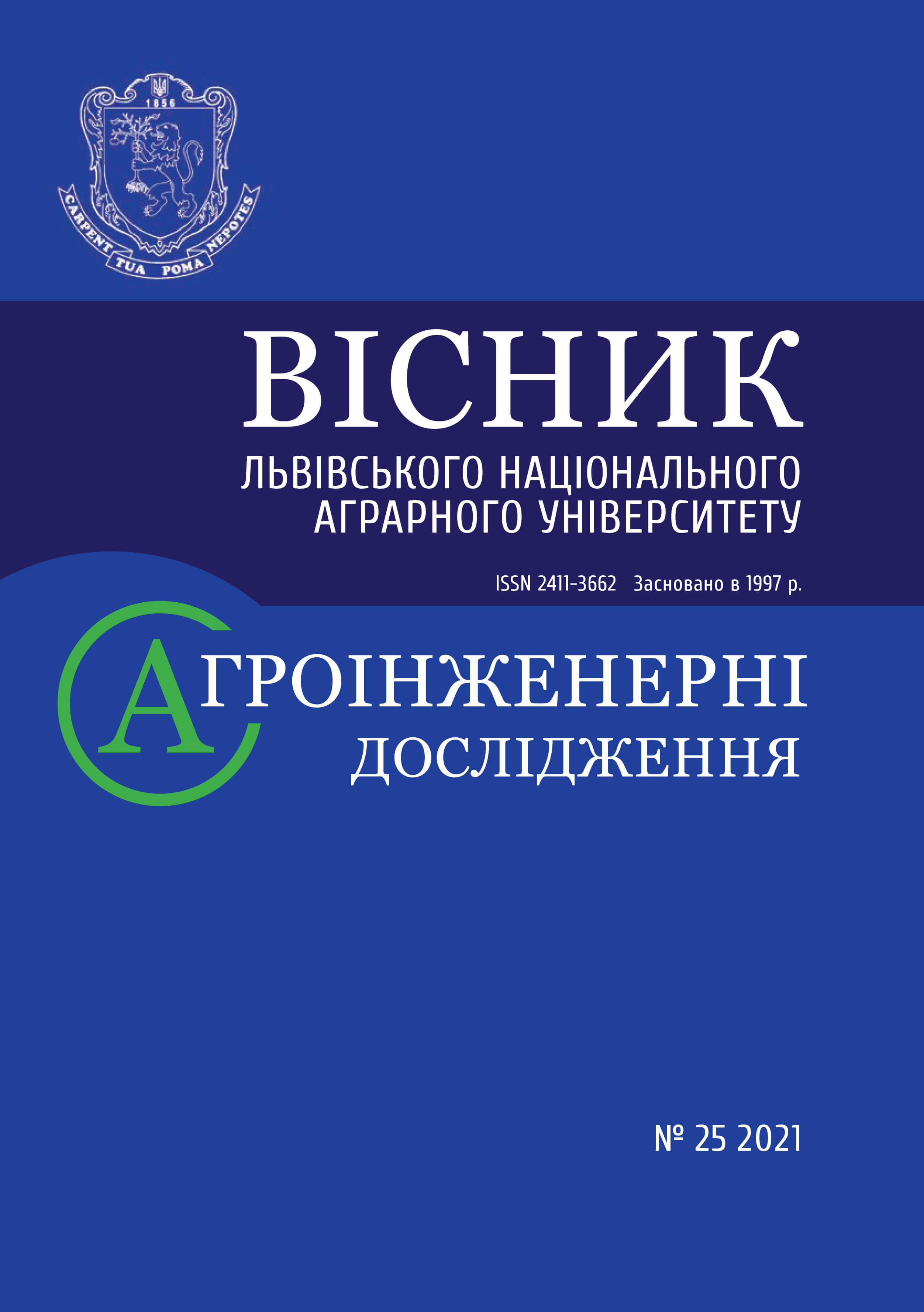Investigation of movement of the sections of seeding machine working bodies for the purpose of energy recovery
DOI:
https://doi.org/10.31734/agroengineering2021.25.092Keywords:
energy recovery, hydraulic cylinder, working body sections, seeding machinesAbstract
Recovery of used energy is one of the directions of energy saving development while using machines and mechanisms. This uses the potential energy accumulated by massive mechanisms or the kinetic energy of the moving elements of machines.
There are also energy recovery reserves in the operation of agricultural machinery. One of such processes is the performance of sowing work by machines, the working bodies of which are placed on moving sections that copy the surface of the field. Since the fields are usually not perfectly flat, there is a high probability of forced movement of the sections relative to the machine frames. The energy generated by the movement of the sections can be considered as energy that can be used for recovery.
Today, the most popular schemes of fastening of sowing sections of drills are parallelogram and radial. The actuator of the recovery system of the movement of the drills sections will be a hydraulic cylinder, the movement of the piston which will create a flow of working fluid. In the parallelogram suspension, the hydraulic cylinder is placed along the line of the larger diagonal of the parallelogram. Accordingly, when copying the relief of the field, the position of the links of the parallelogram mechanism will change, which will cause changes in the length of the diagonal, and in our case – is the movement of the hydraulic cylinder rod. In the radial suspension of the opener section, the stroke of the hydraulic cylinder rod will depend on the change of the vertical position of the opener, as well as on the design features of the section: cross section of the central frame of the opener sections, height of the opener relative to the frame.
As a result of calculations, the equation for definition of length of a course of the hydraulic cylinder rod is received. According to the obtained equations, it is determined that with the field irregularities of 2 cm, the change in the length of the hydraulic cylinder rod for the radial suspension will be within Δn = 0.3 cm, and for the parallelogram suspension – Δp = 0.8 cm. The flow of the working fluid will vary: for the parallelogram suspension sections 4.2–8.2 l/min, for the radial suspension 1.9–3.9 l/min at the speed of the unit 2–4 m/s and provided the use of a hydraulic cylinder with a piston diameter of 40 mm.
The obtained data show that the recovery energy from the movement of sections of the working bodies when copying the terrain deserves attention and requires further research, which must substantiate the hydraulic scheme of the device and methods of energy storage.
References
Awad, M., Sokar, M., Rabbo, S., & El-Arabi, M. (2018). Performance Evaluation and Damping Characteristics of Hydro-Pneumatic Regenerative Suspension System. International Journal of Applied Engineering Research, 13(7), 5436–5442.
Bonavolontà, A., Dolcin, C., Marani, P., Frosina, E., & Senatore, A. (2019). Comparison of energy saving and recovery systems for hydraulic mobile machines. AIP Conference Proceedings. 2191. 020025. doi: 10.1063/1.5138758.
Fang, Z., Guo, X., Xu, L., & Zhang, H. (2013). An Optimal Algorithm for Energy Recovery of Hydraulic Electromagnetic Energy-Regenerative Shock Absorber. Applied Mathematics & Information Sciences, 7, 2207–2214. doi: 10.12785/amis/070610.
Gong, B., Guo, X., Hu, S., & Fang, Z. (2016). The ride comfort and energy-regenerative characteristics analysis of hydraulic-electricity energy regenerative suspension. Journal of Vibroengineering, 18(3), 1765–1782. doi: 10.21595/jve.2016.16746.
Götz, M., Gumpoltsberger, G., & Weinmann, O. (2016). Electrification and Driver Assist Technology in the ZF Innovation Tractor. ATZoffhighway worldwide, 9, 16–21. doi: 10.1007/s41321-016-0539-1.
Ko, J., Ko, S., Kim, Ick-Soo, Hyun, D., & Kim, H. (2014). Co-operative control for regenerative braking and friction braking to increase energy recovery without wheel lock. International Journal of Automotive Technology, 15, 253–262. doi: 10.1007/s12239-014-0026-6.
Mamatov, F., Mirzaev, B., Berdimuratov, P., Turkmenov, Kh., Muratov, L., & Eshchanova, G. (2020). The stability stroke of cotton seeder moulder. IOP Conference Series: Materials Science and Engineering, 883, 012145. doi: 10.1088/1757-899X/883/1/012145.
Olyadnichuk, R. V. (2015). Primenenie nakopitelya energii v sostave pochvoobrabatyivayuschego agregata. MOTROL Commission of Motorization and Energetics in Agriculture,. 17(3), 264–269. [in Russian].
Paulsen, K., & Hensel, F. (2005). Introduction of a new Energy Recovery System – Optimized for the combination with renewable energy. In Conference on Desalination and the Environment, 22–26 May, 2005 (Vol. 184, іssues 1–3, pp. 211–215). Santa Margherita. doi: 10.1016/j.desal.2005.03.060.
Semenov, O., Pidlisnyi, V., Slyva, O., & Yakubov, I. (2016). Reheneratsiia teplovoi enerhii v protsesakh sterylizatsii i pasteryzatsii. Visnyk Lvivskoho natsionalnoho ahrarnoho universytetu: ahroinzhenerni doslidzhennia, 20, 198–202. [in Ukrainian].
Vasilenko, P. M., & Babiy, P. T. (1961). Kultivatory (konstruktsiya, teoriya i raschet). Kiev: UASHN. [in Russian].
Wang, M. (R.), Danzl, P., Larish, Ch., Mahulkar, V., Piyabongkarn, D. (N.), & Brenner, P. (2016). A hydraulic test stand for demonstrating the operation of Eaton’s energy recovery system (ERS). In 10th International Fluid Power Conference, March 8–10, 2016 (Vol. 1, pp. 219–230). Dresden.
Zhang, X., Zhang, Z., Pan, H., Mohammed, W., & Liu, Yu. (2016). A portable high-efficiency electromagnetic energy harvesting system using supercapacitors for renewable energy applications in railroads. Energy Conversion and Management, 118, 287–294. doi: 10.1016/j.enconman.2016.04.012.
Zhang, Z., Zhang, X., Rasim, Ya., Wang, Ch., Du, B., & Yuan, Ya. (2016). Design, modelling and practical tests on a high-voltage kinetic energy harvesting (EH) system for a renewable road tunnel based on linear alternators. Applied Energy, 164, 152–161. doi: 10.1016/j.apenergy.2015.11.096.
Zheng, P., & Gao, J. (2019). Damping force and energy recovery analyis of regenerative hydraulic electric suspension system under road excitation: modelling and numerical simulation. Mathematical Biosciences and Engineering, 16, 6298–6318. doi: 10.3934/mbe.2019314.


